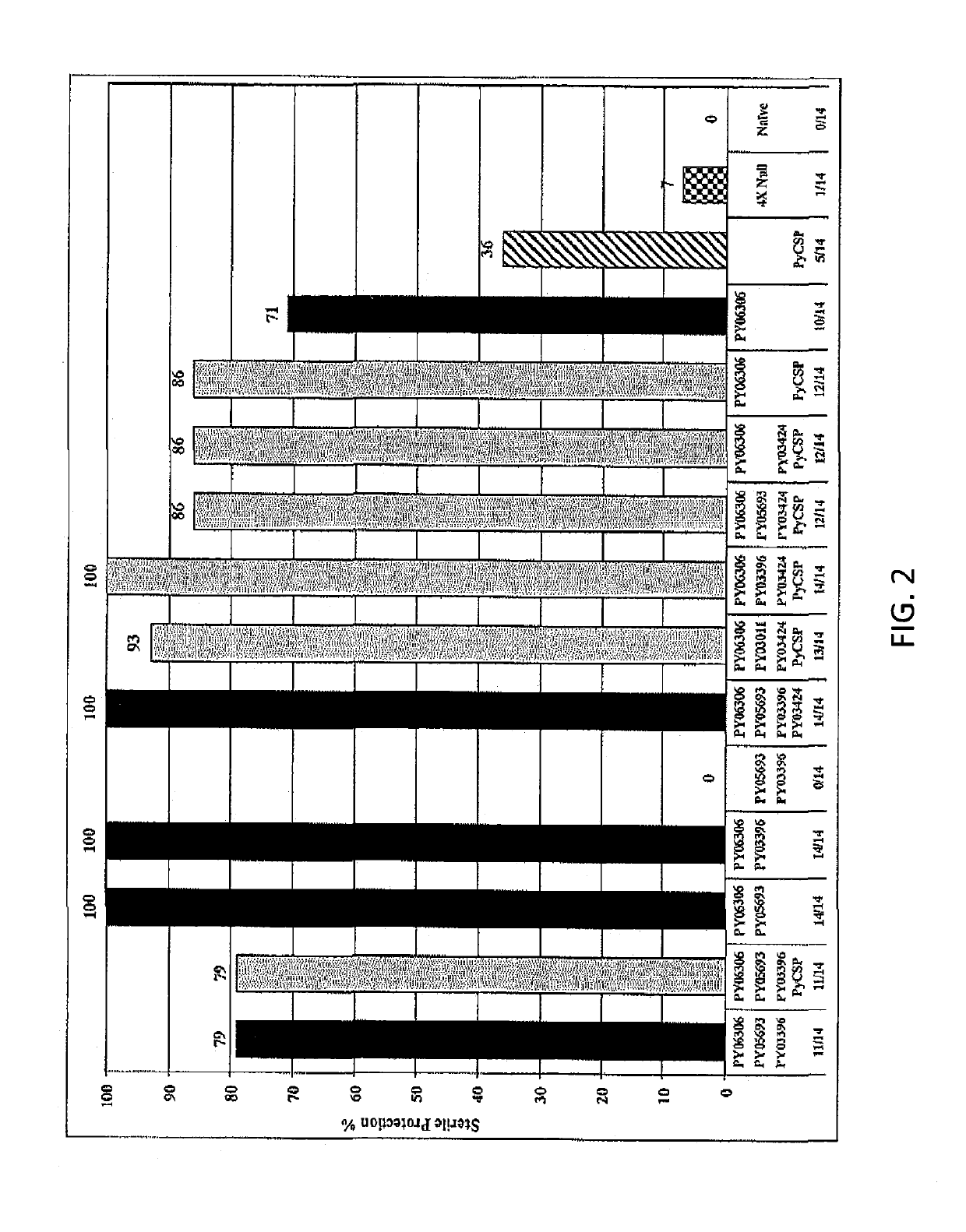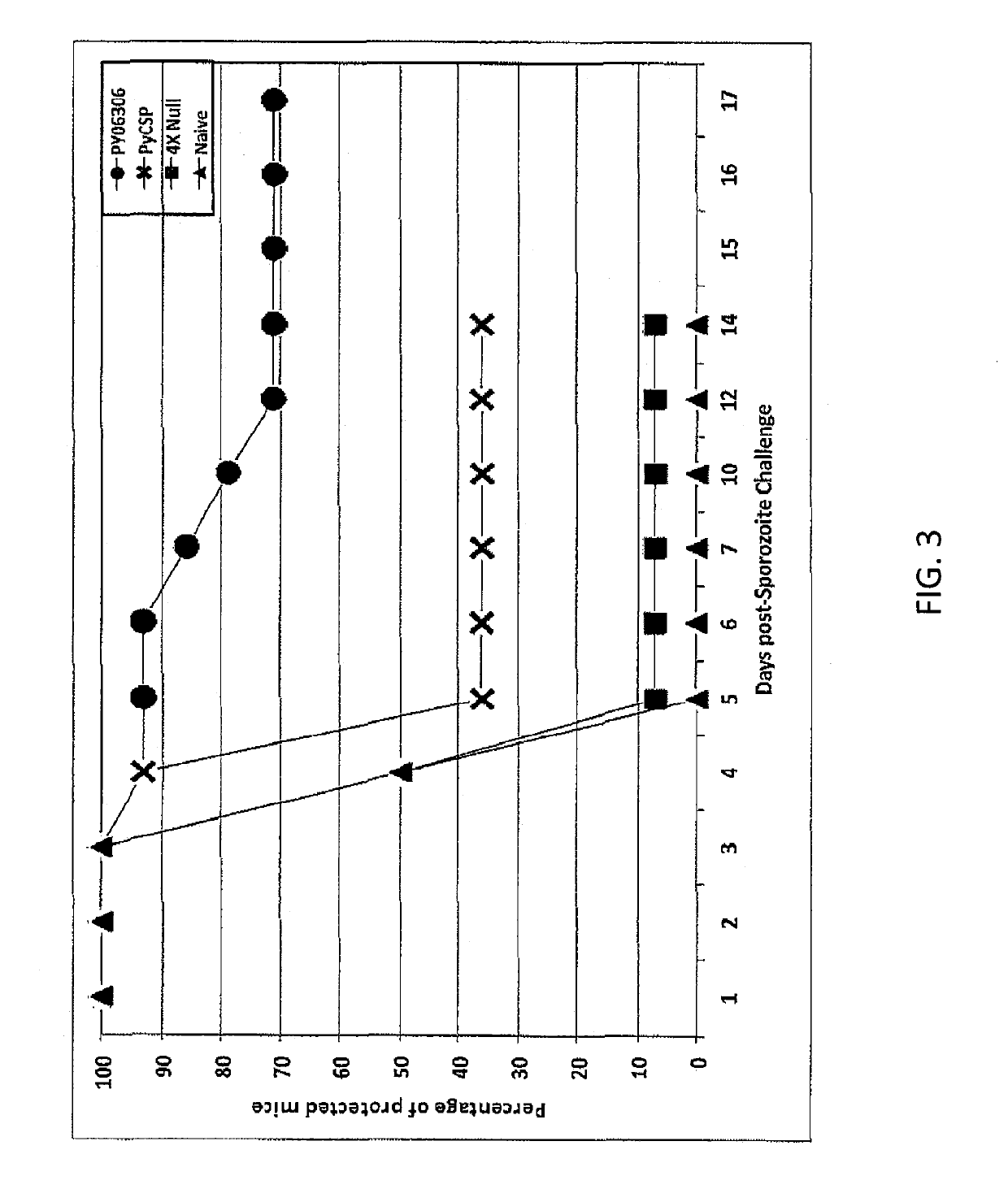Novel antigen for use in malaria
- Summary
- Abstract
- Description
- Claims
- Application Information
AI Technical Summary
Benefits of technology
Problems solved by technology
Method used
Image
Examples
example 1
Identification of E 140
[0061]A novel, highly protective pre-erythrocytic (PE) Plasmodium yoelii (Py) antigen, human orthologs for which are identified for use in a human malaria vaccine. This antigen is identified as PlasmoDB ID 10: PY06306, or PY17X_0210400, PYYM_0211900 or ID: 2121.m00052, depending on the nomenclature used. The antigen is also referred to as E140 or Py E140 in laboratory testing disclosed herein as a shorthand. The novel antigen is highly expressed in the sporozoite, liver, and blood stages of the parasite, and induces CD8+ T cell responses in mice immunized with the P. yoelii radiation-attenuated sporozoites (RAS). It generates strong antibody and cellular responses upon antigen-specific vaccine immunizations and sterilely protects between 71%-100% alone and in combination with other antigens of mice from an infectious P. yoelii sporozoite and blood stage challenges. First, P. yoelii pre-erythrocytic antigens were screened for their reactivity to T cells from RA...
example 2
Confirming E140 Protection
[0062]Two vaccine reagents were made expressing the PY06306 antigen for protection studies in mice. These reagents were generated with the full-length gene: DNA vaccine in the VR1020 plasmid (PY06306-E140) and adenovirus serotype 5 (AdE1(t.PY06306)E3(10X)E4(TIS1)). The evidence for vaccine potential of the PY06306 antigen is shown in two separate animal matrix studies, intended to assess the ability of the antigen to induce an immune response capable of sterilely protecting mice from an infectious Py sporozoite challenge. The sterile protection was measured by the absence of parasites in the blood of mice examined up to 14 or 17 days post sporozoite challenge. Outbred CD1 mice were immunized with a regimen consisting of a prime with DNA vaccine (100 μg, IM) and a boost with adenovirus serotype 5 constructs (1010 PU, IM) 6 weeks later. A 3-antigen combination strategy (named matrix) was adopted to test the PY06306 antigen plus other new Py pre-erythrocytic a...
example 3
Sporozoite Challenge
[0064]A second study (Matrix Deconvolution Experiment 2) was designed to evaluate several antigen combinations having the PY063Q6 as the common denominator antigen. The experimental format and immunizations followed the same regimen as described for the first matrix experiment. FIGS. 1 and 2 show the markedly high efficacy for all antigen combinations that include the PY06306 (E140) antigen, ranging from 71% to 100% of the mice protected. Overall, 89% (137 / 154) of PY06306-immunized mice were protected from malaria infection. The PY06306 vaccine alone yielded 71% protection, significantly higher compared to 36% for the PyCSP alone group. Furthermore, there was a substantial delay in the onset of parasitaemia of non-protected mice as shown in FIG. 3. Detailed analysis of blood smears data from the PY06306-immunized group shows that three of the four non-protected mice became malaria positive on days 7, 10 and 12 after sporozoite challenge. This is significant when ...
PUM
| Property | Measurement | Unit |
|---|---|---|
| Fraction | aaaaa | aaaaa |
| Volume | aaaaa | aaaaa |
| Immunogenicity | aaaaa | aaaaa |
Abstract
Description
Claims
Application Information
 Login to View More
Login to View More - R&D
- Intellectual Property
- Life Sciences
- Materials
- Tech Scout
- Unparalleled Data Quality
- Higher Quality Content
- 60% Fewer Hallucinations
Browse by: Latest US Patents, China's latest patents, Technical Efficacy Thesaurus, Application Domain, Technology Topic, Popular Technical Reports.
© 2025 PatSnap. All rights reserved.Legal|Privacy policy|Modern Slavery Act Transparency Statement|Sitemap|About US| Contact US: help@patsnap.com



